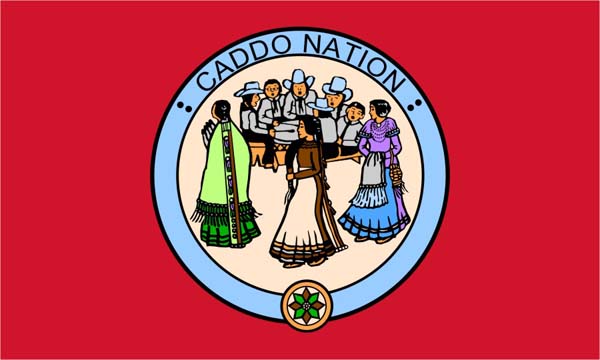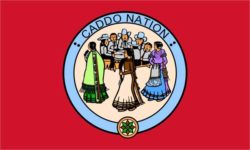Caddo Nation
Caddo people began to inhabit the Red River valley approximately 2,500 years ago.

Courtesy of Wikimedia Commons
Flag of the Caddo Nation. Caddo Nation; rendering by Wikimedia Commons user Walden
Caddo people began to inhabit the Red River valley approximately 2,500 years ago. Around that time, the ancestors of the southern Caddos began to settle in permanent villages, build the first mounds, cultivate plants, and develop the use of ceramics. The backbone of the Caddo world was the Red River, but their extensive traditional territory, known as the Caddoan area, included southwestern Arkansas, northwestern Louisiana, northeastern Texas, and southeastern Oklahoma. The southern Caddos are related linguistically to the Wichita, Pawnee, and the Arikara through the Caddoan language group.
Caddo Organization
The early Caddos settled in hamlets and dispersed villages and occupied ceremonial centers with mounds for elite burials and ritual activities. They produced elaborate cane basketry, shell work, and ceramics and were renowned for their bois d’arc (Osage orange) bows, which they traded, along with salt and other goods, across the American Southeast and southern plains. The Caddos were sedentary and practiced agriculture, growing maize, beans, squash, and pumpkins. They also gathered seasonal foods such as nuts and berries and hunted extensively. The Caddos maintained a central religious and civil authority in their villages and ceremonial centers, each of which was structured around a hereditary chiefly lineage. Caddo kinship was primarily matrilineal, but by the time of European contact Caddo descent was trending toward a more bilateral system.
By the Late Caddoan Period, c. 1300–1680, the Caddos were organized in a widespread system of rural communities along rivers and streams. Late Caddo mound sites ranged from one to four small mounds, with larger towns placed along major waterways, primarily the Red and Ouachita Rivers. At the time of European contact in the late seventeenth century, the era of Caddo mound building was drawing to a close, although Caddo people continued to utilize some mounds for ceremonial activities. The Caddos also participated in a vast social as well as trading network. Therefore, the Spanish in Texas and the French in Louisiana were anxious to make alliances with the Caddo Nation.
There were at least sixteen separate Caddo groups at the end of the seventeenth century. Variously referred to as villages, bands, or tribes, the nature of these divisions and their relationship to one another is poorly understood. Recognized as separate entities by colonial and US territorial administrators, by the mid-seventeenth century the Red River bands were collectively identified as “Caddo,” derived from Kadohadacho, the primary Caddo division in the Red River Valley. Although early geographic groupings have been identified as confederacies, the arrangement of Caddo villages reflects a typical Southeastern pattern of east and west divisions of people connected by both kinship and tradition.
Population data for the Caddos at the beginning of the colonial period (c. 1680–1700) is sketchy at best. Estimates range from 6,000 to as many as 250,000 precontact Caddos. What is certain is that by the time France established an outpost at Natchitoches in 1714, the Caddos had already suffered drastic population loss resulting from the introduction of European pathogens such as influenza and smallpox, to which they had no immunities. The Caddo population continued to decline throughout the remainder of the colonial period and beyond, reaching a population nadir of about five hundred people in the 1890s.
The Arrival of European Settlers
The Caddos welcomed French colonials, who exchanged prestigious European goods like weapons, cloth, mirrors, and glass beads for deer hides, bear oil, livestock, and enslaved Indians. French traders often took Caddo wives, and the nations formed a strong alliance through French Canadian adventurer Louis Juchereau de St. Denis and his descendants. Interactions between the St. Denis family and the Caddos came to dominate the regional economy in the Red River valley throughout the eighteenth century. Colonial governors and administrators maintained diplomatic and commercial relations with the Caddos through a series of long-tenured chiefs called kaadii. The paramount Caddo chiefdom was centered in the Nasoni village near present-day Texarkana. Consolidation of the disparate Caddo divisions under this authority would intensify as Caddo population diminished in the late eighteenth century.
Throughout the French colonial period, the Caddo were treated as valued allies whose goodwill was secured through kinship, both real and fictive, as well as access to European goods, annual gifts, and advantages in trade. To the west, Spain had established largely ineffective missions among the Texas Caddos, who were attracted instead to French traders in Louisiana. Upon assuming control of the colony in 1763, Spain was forced to model its Indian policy on French practices. Spanish administrators appointed French Creoles with whom the Caddos had long-standing relationships to administer trade with the Indian nations. The mission system, a demonstrated failure among the Caddos in Spanish Texas, was abandoned altogether during the Spanish colonial period.
Despite its vast natural resources, Louisiana was an expensive colony with low rates of return for Spain. Spain was forced to retrocede Louisiana to France in 1800. Three years later, the United States purchased Louisiana and gained control over the port of Orleans and the Mississippi River. Under the Americans, conditions of existence for the Caddos would be dramatically and irrevocably altered. Vast, exploitable natural resources and tremendous agricultural potential drew thousands of American immigrants across the Mississippi River to establish plantations, farms, and businesses. The present state of Louisiana east of the Mississippi River saw fourteen thousand Anglo-American immigrants arrive by 1808. From New Orleans north and west, cotton and sugar plantations built upon slave labor flourished and, by 1812, cleared fields extended up Red River as far as Natchitoches.
At first, American territorial administrators maintained the status quo in structuring interaction with Louisiana Indians. As trade diminished in importance, however, and more Americans realized the agricultural potential of the rich Red River valley, the Caddos found themselves increasingly marginalized. Competition for territory bred animosity between the American immigrants and the Caddos. In 1835, the Red River Caddos were forced to cede their traditional territory east of the Sabine River to the United States and join their relatives in Spanish Texas. The consolidated nation would find a permanent home in 1859, when the Caddos settled in the Washita River valley in Indian Territory (in present-day Oklahoma). Not until 1935 were the Caddos invited back to their homelands for the Shreveport centennial celebration. The city invited the Caddos to participate once again at the sesquicentennial in 1985.
In the ensuing century and a half, the Caddo Nation has maintained autonomy as a sovereign tribal nation with its own unique set of songs and dances, material culture, and language. The Turkey Dance is a series of more than fifty songs that are remembered in many Caddo dialects and recount occurrences in tribal history, including important battles and the creation of Caddo Lake. The Drum Dance documents Caddo cosmology and origins. Drummers lead dancers clockwise around the ground, stopping at each of the four cardinal directions. When the procession has completed its journey, the Caddos have effectively reenacted their cultural beginnings.
The contemporary tribal complex, which includes a museum and two community dance grounds, is situated in Binger, Caddo County, Oklahoma. The tribal administration includes the Cultural Preservation Office and Caddo Repatriation Committee, made up of elders who offer guidance on issues of archaeological and historical concern. Two cultural groups—the Caddo Culture Club and the Hasinai Club—work with tribal youth to conserve and perpetuate Caddo culture. In the twenty-first century, Caddo people maintain close ties to their traditional homelands in Louisiana, returning often to honor their ancestors, revisit important sites, consult with academic and museum specialists, and dance on their ancient lands.
